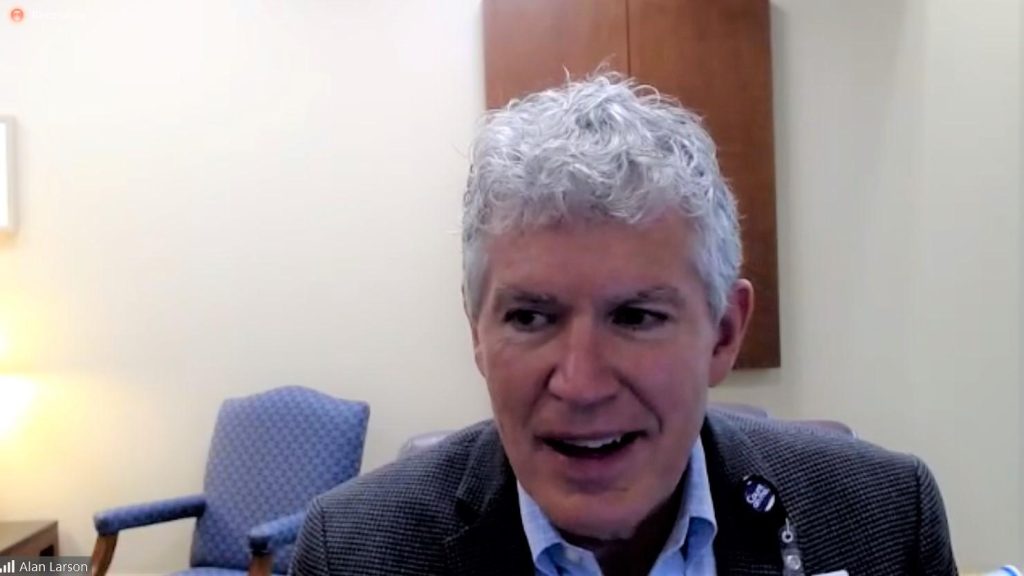Positive pause as hospital restrictions eased, visiting hours expand
By Callie Hietala
As community transmission of COVID-19 slows in the area, Sovah Health is easing pandemic era restrictions on hospital visitors. Officials announced last week that, effective Monday, March 14, the healthcare system is reopening visitation at its two hospitals to family, friends, and other guests as well as expanding visitation hours.
“For the better part of two years, we have restricted visitation significantly for the protection of the visitors, our staff, and our patients,” said Alan Larson, Sovah Health’s market president and CEO of Sovah Health-Danville. “We feel like we’re in a spot now where we need to make the community aware that the hospital needs them to participate in the healing art of healthcare.”
One of the most difficult things for a hospital patient during the pandemic was not having the support and comfort of friends and family during their hospital stays, said Spencer Thomas, CEO of Sovah Health-Martinsville. Now, the hospital wants to allow as much opportunity as possible for those interactions to happen once again.
Patients in the qualifying units, including outpatient services and most inpatient units, may have two well visitors at a time, with the ability to interchange, during visitation hours.
For pediatric patients, the two visitors must be parents or guardians. Labor and delivery patients are allowed two well support visitors during labor and one well support person for their entire hospital stay after delivery, in addition to a second well visitor during visitation hours.
Patients in the emergency department will be allowed one well visitor after being placed in a room; patients who are in isolation, immunocompromised, or are under observation or test positive for COVID-19 are now allowed one well visitor.
All visitors must be aged 12 or older. All will still be screened for symptoms of COVID-19 upon entry.
Visiting hours will be from 8 a.m. until 8 p.m. seven days a week in most areas of the hospital, Visitation in the ICU will be at the discretion of ICU staff, as it was before the pandemic.
Thomas said visitors are still be expected to wear a mask while inside the hospital.
Dr. Sheranda Gunn-Nolan, market chief medical officer, said hospital staff will continue to wear masks and personal protective equipment (PPE) because the Centers for Disease Control and Prevention’s (CDC) recent update to mask-wearing guidelines does not extend to healthcare professionals.
Thomas said the easing of visitation restrictions comes after both sites of Sovah hospitals have seen a “steady decline” in the total number of COVID-19 patients. National trends indicate that decline is not isolated to the local community.
According to information from the health department, Thomas said both Martinsville and Danville are classified as areas of moderate COVID transmission. Just a few weeks ago, they were both classified as high transmission areas.
According to the CDC’s online map reflecting community transmission levels by county, Henry County is categorized as low transmission. The map was last updated March 10.
As of March 10, there were fewer than 10 patients in both hospitals admitted for COVID-19, two-thirds of which were in Martinsville and one-third in Danville, according to Gunn-Nolan, who said the statistic is one of the lowest she’s been able to report in a long time.
Sovah Health does not disclose exact numbers of COVID-19 patients due to patient privacy concerns, Larson explained.
Gunn-Nolan said those who are not vaccinated remain 4.3 times more likely to contract the virus.
Officials called the change in visitation policy a “positive pause” in the pandemic-related restrictions that have been in place for more than two years. Gunn-Nolan said that last Thursday marked day 723 of talking about COVID.
“I think there’s a palpable sense of gratitude that we’ve gotten through another surge,” Larson said, but cautioned that “other variants are out there,” and yet another surge could come.
“This virus by its nature will continue to mutate until we get to a sufficient herd immunity that will keep this at bay,” he said.
However, Larson said that, over the past several years dealing with and learning about the virus, hospital staff is beginning to “gain confidence that we can manage what we’re asked to take care of” should another outbreak occur.






